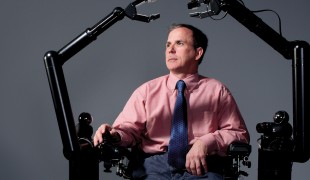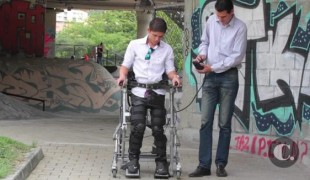- 4607
- 281
- 7
- 10
- 0
- Help Ukraine
About the solution
Medical staff were able to fix him up again, but walking and standing became increasingly difficult with age. In 2003, while living in the US, Hartmut warmed to the idea of acquiring a mobility scooter.
However, none of the countless mobility scooters on the market met the basic requirement of being easy to load and unload in and out of his homebuilt airplane. He faced similar problems when dealing with portability in cars and public transport.
Without exception, all mobility scooters were too heavy and bulky. Frequently, people with disabilities already have difficulty lifting heavy objects; or, oftentimes the wife has to handle that task for her disabled husband, for example. Several mobility scooters that could be taken apart where introduced onto the market, but these weren’t any lighter. They were still too cumbersome and complicated for people with disabilities. An entirely new approach had to be taken.
A few years prior, light-weight aluminum scooters for children as well as adults became popular world-wide: This gave Hartmut Huber his inspiration. After about a year of development he introduced the World’s lightest and most compact electric mobility scooter and named it TravelScoot ™, and applied for a patent.
This scooter his much lighter and has more load capacity than the other scooters.
Adapted from: http://travelscoot.com/inventor.html
What about you, do you have any solutions? Please share them with the Patient Innovation community!
This solution shall not include mention to the use of drugs, chemicals or biologicals (including food); invasive devices; offensive, commercial or inherently dangerous content. This solution was not medically validated. Proceed with caution! If you have any doubts, please consult with a health professional.
DISCLAIMER: This story was written by someone who is not the author of the solution, therefore please be advised that, although it was written with the utmost respect for the innovation and the innovator, there can be some incorrect statements. If you find any errors please contact the patient Innovation team via info@patient-innovation.com
-
-
456
-
0
-
7318

Paralyzed man designs innovative wheelchairs
CAREGIVING
MOVING IN A WHEELCHAIR: Moving using a wheelchair.
Grip
Rubgy
Basketball
Paralysis
Cervical spinal cord injury/Tetraplegia
Assistive Daily Life Device (to help ADL)
Assistive Technology access
Walking Aid (wheelchair/walker/crutches)
Restoring mobility
Replacing lost limbs
Promoting self-management
Promoting inclusivity and social integration
Recovering from Traumatic Injuries
Preventing (Vaccination, Protection, Falls, Research/Mapping)
Caregiving Support
Neurology
Orthopedics
Physical Medicine and Rehabilitation
United States
-
-
-
462
-
0
-
6645

Engineer develops low cost exoskeleton inspired by a friend
WALKING: Walking
MOVING IN A WHEELCHAIR: Moving using a wheelchair.
Spinal Cord and Nerve Root Disorders
Accident
Cervical spinal cord injury/Tetraplegia
Walking Aid (wheelchair/walker/crutches)
Assistive Daily Life Device (to help ADL)
Muscle cramps or spasms
Stiffness or rigidity (difficulty moving)
Paralysis of the legs and lower body
Muscle weakness
Restoring mobility
Promoting self-management
Managing Neurological Disorders
Promoting inclusivity and social integration
Preventing (Vaccination, Protection, Falls, Research/Mapping)
Neurology
Orthopedics
Colombia
-
-
-
290
-
0
-
3385

Teacher Alex Truesdell is Transforming Lives: Adaptive Design Association Revolutionizes Disability Solutions
CAREGIVING
Drawing
Painting
Playing
BODY BALANCE: Maintaining body balance
(SELF)-CARE: DRINKING: Drinking independently.
(SELF)-CARE: EATING: Eating independently.
MOVING IN A WHEELCHAIR: Moving using a wheelchair.
Playing an instrument
Studying
Blindness
Hand Deformity
Neuromuscular Disorders
Assistive Daily Life Device (to help ADL)
Walking Aid (wheelchair/walker/crutches)
Restoring mobility
Replacing lost limbs
Enhancing health literacy
Promoting self-management
Promoting inclusivity and social integration
To improve Treatment/Therapy
Preventing (Vaccination, Protection, Falls, Research/Mapping)
Raise awareness
Caregiving Support
General and Family Medicine
Internal Medicine
Orthopedics
Pediatrics
Physical Medicine and Rehabilitation
United States
-
 en
en